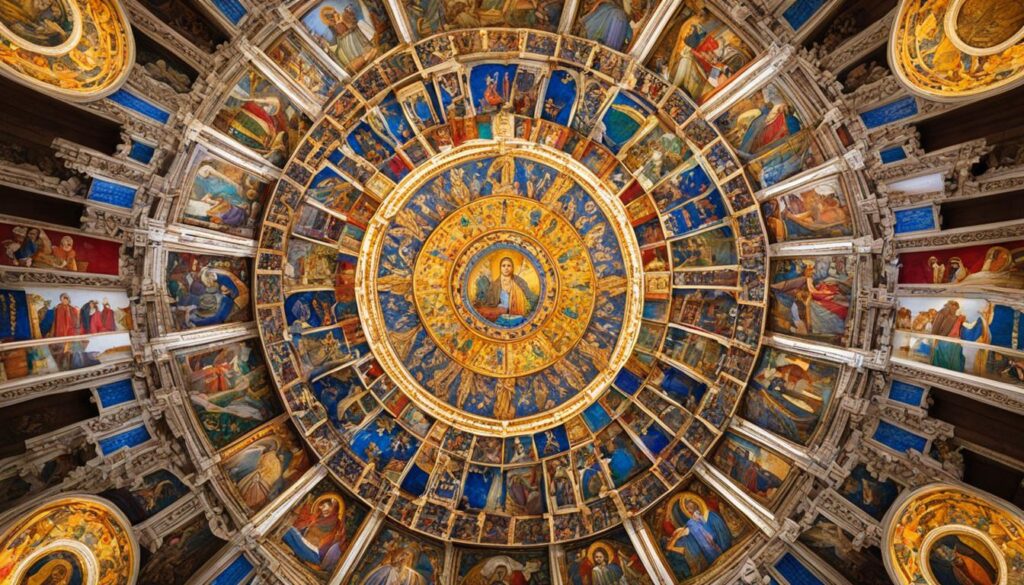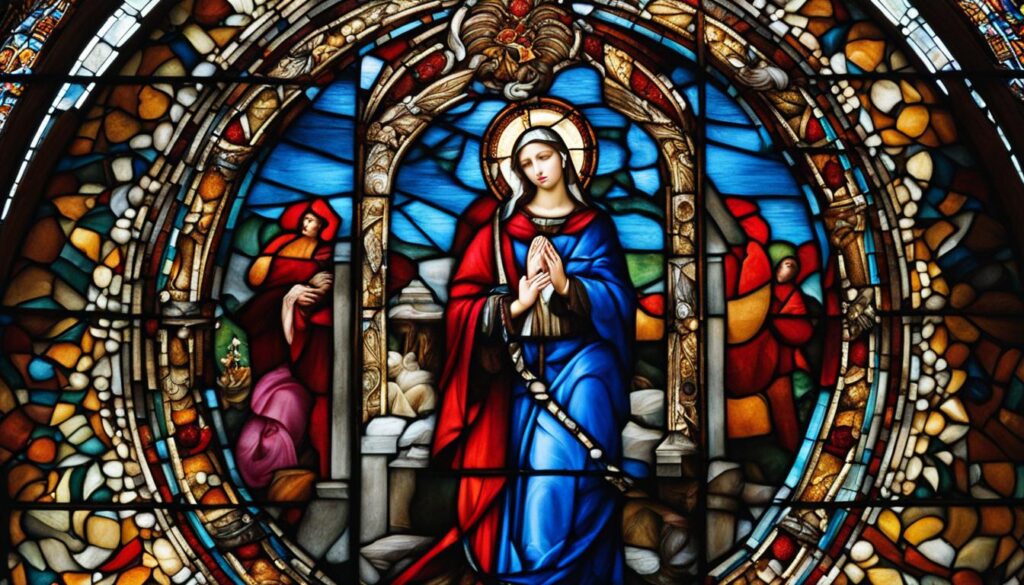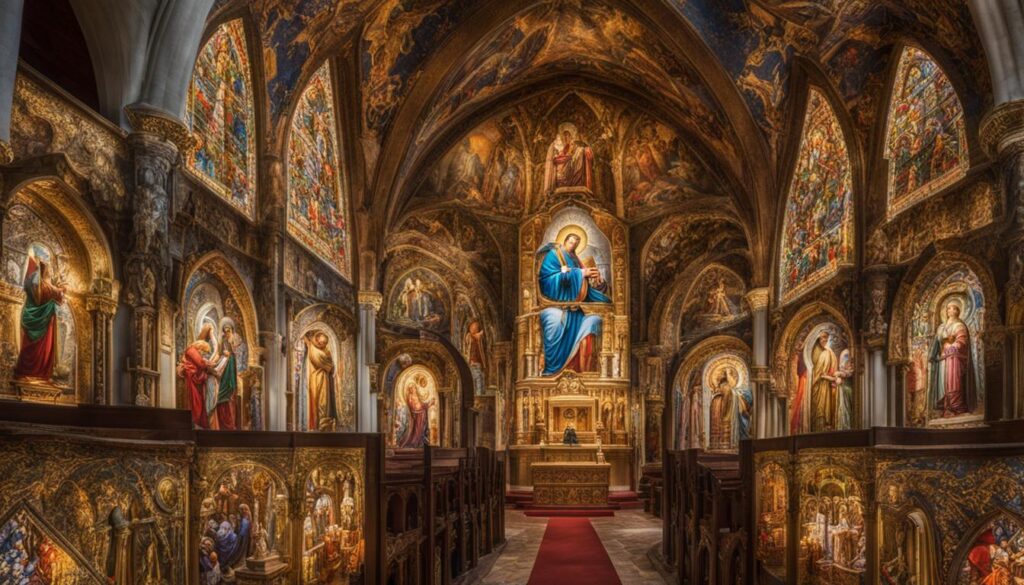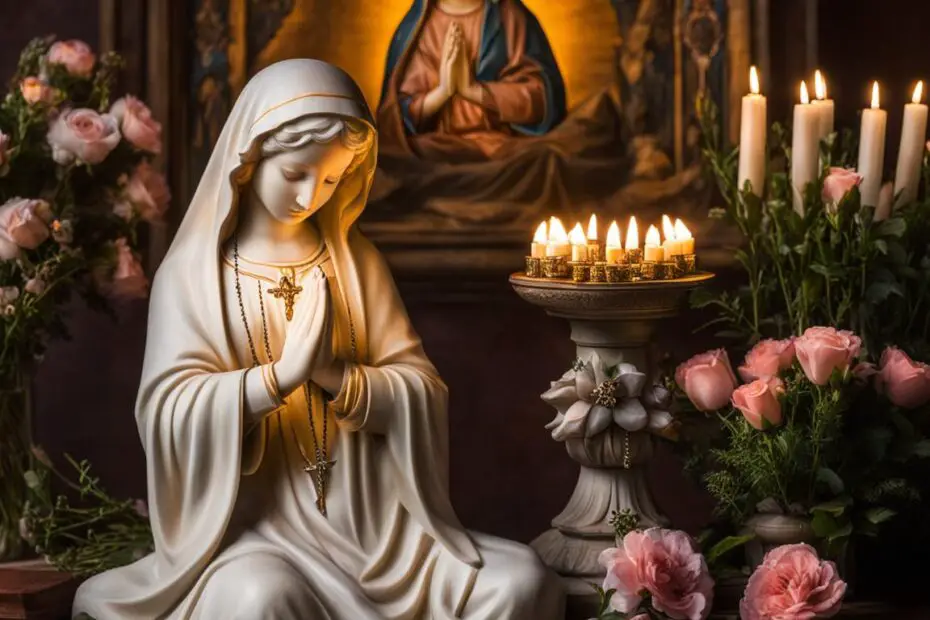Catholics have a rich and ancient prayer tradition that has been an integral part of their spiritual lives. This tradition encompasses a multitude of practices, rituals, customs, and techniques that have been developed over centuries. Through the exploration of these prayer practices, Catholics can deepen their connection with God and enhance their understanding of the faith.
In this article, we will delve into the various dimensions of the praying Catholic tradition, shedding light on the significance of prayer in the Catholic Church. From private devotions to communal prayer practices, we will uncover the diverse range of ways in which Catholics engage in prayer.
Join us as we embark on a journey to explore the historical roots, structure, and importance of the prayers within the Catholic tradition. Whether you are new to Catholic prayer practices or have been practicing for years, this article will provide valuable insights and guidance to help you deepen your prayer life.
Key Takeaways:
- Catholics have a rich and ancient prayer tradition that shapes their spiritual lives.
- Prayer practices in the Catholic tradition encompass private devotions, communal prayer, and personal shrines.
- Understanding the historical context and practices can invigorate personal prayer lives and deepen faith.
- Exploring the depth of the praying Catholic tradition provides a framework to connect with one’s beliefs and reflect on scripture and doctrine.
- Through prayer, Catholics can communicate with the divine, express concerns, and foster unity within the Church community.
Historical Background of Prayers of the Faithful
The Prayers of the Faithful have an enduring presence within the Catholic Church, rooted in its rich history and liturgical practices. These intercessory prayers have evolved over time, reflecting the changing needs and spiritual aspirations of the faithful. Beginning as simple communal expressions of faith, they have grown to become a structured and integral part of traditional Catholic worship.
Throughout centuries, the prayers have held a significant place within the Church’s liturgical framework, symbolizing the communal dialogue between the faithful and the divine. They have provided a platform for believers to unite their voices and offer intentions for a myriad of concerns, embracing both personal and global issues.
The historical background of the Prayers of the Faithful dates back to the early Christian communities, where communal prayers were often recited for intercession and spiritual guidance. As the liturgical practices of the Catholic Church developed, these prayers gained prominence, eventually becoming an integral part of the Mass and other sacramental celebrations.
These prayers have transcended time and cultural contexts, steadfastly representing the universal nature of faith within the Catholic community. They offer a spiritual and communal experience that unites believers across generations, continents, and traditions.
Structure of Prayers of the Faithful
Prayers of the Faithful follow a specific format and include intentions that cover a wide range of topics. These intentions can address both global issues and personal concerns, allowing believers to connect with their beliefs on a deeper level. Over time, the structure of these prayers has evolved to remain relevant in the ever-changing context of the Church.
The structure of the Prayers of the Faithful provides a framework for the faithful to reflect the teachings of scripture and doctrine. It begins with a call to prayer, followed by the selection of intentions. These intentions can encompass various aspects of life, including individuals, communities, the Church, and the world at large. The prayers typically conclude with a concluding prayer or a communal response, reinforcing the sense of unity and shared purpose among the faithful.
Through the structured format of the Prayers of the Faithful, believers can express their deepest concerns, hopes, and aspirations. This form of prayer allows for a collective voice, emphasizing the communal nature of Catholic worship.

Example Structure of Prayers of the Faithful
| Element | Description |
|---|---|
| Call to Prayer | An invitation to the congregation to join in prayer, often led by the presiding minister. |
| Selection of Intentions | Various intentions are chosen, representing different aspects of life, including global issues, personal concerns, and community needs. |
| Prayer of the Faithful | Each intention is presented, followed by a moment of silent reflection and prayer from the congregation. |
| Concluding Prayer/Response | A prayer or communal response that summarizes the intentions and concludes the Prayers of the Faithful. |
The example table above showcases a typical structure of the Prayers of the Faithful. It serves as a guide for both clergy members and the congregation, ensuring consistency and providing a clear framework for meaningful prayer.
Importance of Prayers of the Faithful in Catholic Worship
The prayers of the faithful hold a sacred and cherished place within Catholic worship, serving as a powerful means of communication between the faithful and the divine. These prayers provide a platform for believers to express their deepest concerns, aspirations, and gratitude, creating a profound connection with their faith.
As reflections of the teachings of scripture and doctrine, prayers of the faithful allow the community to engage in a meaningful dialogue with God. Through these prayers, the faithful can align their thoughts and intentions with the teachings of the Church, seeking guidance, solace, and inspiration in their spiritual journey.
Moreover, prayers of the faithful contribute to the overall spiritual well-being of the Church. By coming together as a community to lift collective prayers, the faithful foster a sense of unity and shared purpose. These prayers remind believers of their interconnectedness and the power of communal worship, reinforcing the bonds of fellowship and strengthening their devotion.
“The prayers of the faithful enable us to express our deepest concerns, hopes, and desires to God. They are an integral part of our worship, allowing us to actively participate in the sacred dialogue between heaven and earth.” – Bishop Robert J. Brennan
Engaging in prayers of the faithful is not only an act of worship but also a means of personal and spiritual growth. By pausing to reflect on their own concerns and desires, individuals gain a deeper understanding of their relationship with God and the teachings of the Church. Through these prayers, believers are encouraged to cultivate empathy, compassion, and a genuine concern for others.
The importance of prayers of the faithful in Catholic worship cannot be overstated. They provide a vessel for believers to pour out their hearts and souls, seeking solace, guidance, and grace. As an essential element of the Catholic tradition, these prayers embody the core values of faith, unity, and reflection of teachings.

How to Engage with Prayers of the Faithful
To have a deeper connection with your faith, it is essential to engage with Prayers of the Faithful personally. This active participation allows you to incorporate your personal intentions and navigate the contemplative process. By following these steps, you can deepen your relationship with God and experience a more profound sense of spiritual connection.
- Reflect on your personal intentions: Before engaging with Prayers of the Faithful, take a moment to reflect on your personal intentions. Consider your own needs, the needs of your loved ones, and the larger community. By identifying these intentions, you can infuse these prayers with your heartfelt desires and concerns.
- Embrace the contemplative process: As you engage with Prayers of the Faithful, embrace the contemplative process. Take the time to quiet your mind, open your heart, and truly immerse yourself in the prayers. Allow yourself to be present in the moment and connect with the divine through your intentions.
- Participate actively: Actively participate in the Prayers of the Faithful by listening attentively and responding sincerely. As the intentions are offered, mentally or verbally affirm your support and join in the collective prayer. This active engagement reinforces the sense of unity among the faithful and strengthens the power of the prayers.
- Seek guidance from scripture and tradition: Draw inspiration from scripture and tradition as you engage with Prayers of the Faithful. Consider relevant passages or teachings that align with your intentions. By grounding your prayers in the wisdom of the Church, you can deepen your understanding and connection to the broader faith community.
Through engaging with Prayers of the Faithful, you embark on a transformative journey of personal growth and spiritual development. By incorporating your personal intentions and embracing the contemplative process, you can cultivate a more profound relationship with God and find solace in the community of believers.

Example of Personal Intention:
“Lord, I offer this prayer for healing and strength for my friend Maria, who is facing a challenging illness. May your divine love and grace surround her during this difficult time, bringing comfort and renewal. Amen.”
Common Themes and Topics in Prayers of the Faithful
Prayers of the Faithful encompass a wide range of themes and concerns that resonate with the diverse experiences of the faithful. These prayers serve as powerful vehicles for expressing deep-rooted emotions, hopes, and aspirations. Through heartfelt petitions, believers seek solace, guidance, and divine intervention in various aspects of life.
Peace and Justice: A prevailing theme in Prayers of the Faithful is the pursuit of peace and justice in our world. This theme reflects the intrinsic desire to create a harmonious society where all individuals can thrive and live in harmony, free from violence and oppression.
Expressions of Gratitude: Gratitude is another recurrent theme in these prayers, highlighting the importance of appreciating the blessings and favors bestowed upon us. Expressions of gratitude acknowledge the goodness of God and encourage a spirit of thankfulness and humility within the worshiping community.
“We pray for peace in our world, that conflicts may be resolved and justice may prevail. Let us be instruments of peace in our daily lives, spreading love and understanding to all we encounter.”
Additionally, Prayers of the Faithful often encompass specific petitions for the well-being and needs of the community. These prayers provide an opportunity for believers to come together as one, interceding for those who are suffering, facing challenges, or in need of healing.
- Petitions for physical and mental wellness
- Prayers for guidance and wisdom
- Intercessions for the vulnerable and marginalized
- Requests for strength and resilience
- Petitions for unity and reconciliation among individuals and nations
These common themes in Prayers of the Faithful reflect the deep longing for peace, justice, gratitude, and the shared human experiences that unite believers. They inspire individuals to seek spiritual growth, cultivate empathy, and promote positive change in the world.
“May our hearts overflow with gratitude for the blessings we have received, and may we share our abundance with those in need. Guide us, O Lord, to be generous and compassionate stewards of your gifts.”

Through the exploration of these themes, individuals can deepen their connection with the divine, align their intentions with God’s will, and actively participate in the transformative power of Prayers of the Faithful.
Variations in Prayers of the Faithful Across Catholic Traditions
While the core essence of Prayers of the Faithful remains the same across Catholic traditions, there are fascinating variations in their execution. Different denominations and cultural contexts bring forth their unique customs and prayers, enriching the diversity within the Catholic faith.
These variations reflect the vibrant tapestry of Catholic denominations and the cultural contexts in which they flourish. From the richly intricate prayers of the Eastern Orthodox tradition to the heartfelt petitions of Latin American Catholicism, each variation adds a unique flavor and depth to the practice of Prayers of the Faithful.
Understanding and appreciating these variations allow us to embrace the beauty of unity amidst diversity within the Catholic faith. It invites us to delve into different prayer customs, drawing inspiration from fellow believers and their cultural expressions of faith.
Embracing the Mosaic of Prayer
The variations in Prayers of the Faithful spring forth from the dynamic nature of Catholicism itself. As the faith has spread across different regions and cultures, it has adapted and integrated local customs and traditions. These variations serve as a testament to the unifying power of prayer, transcending borders and cultural boundaries.
“The rich diversity within the Catholic faith testifies to the universality and adaptability of our prayers. It is in embracing these variations that we truly uncover the beauty and strength of Catholic traditions.” – [Real Name], The Power of Prayer
Exploring Catholic Denominations
Each Catholic denomination brings its distinctive customs and practices to the Prayers of the Faithful. For example, the Byzantine Catholic Church, with its Eastern Christian heritage, employs intricate litanies that reflect the depth of mystical theology. On the other hand, the Anglican tradition preserves a unique combination of ancient prayers and contemporary intercessions, reflecting its historical roots and ongoing dialogue with modern society.
Furthermore, as Catholicism exists within different cultural milieus, we witness the interplay between religious and cultural practices in the form of Prayers of the Faithful. Latin American Catholicism, deeply infused with indigenous traditions, often includes invocations for the well-being of the natural world and communal harmony.
Broadening Our Understanding
By acknowledging and studying the variations in Prayers of the faithful, we gain a broader understanding of the multi-faceted nature of Catholicism. It invites us to step beyond our comfort zones and explore the profound connections that prayer fosters across diverse cultural and denominational contexts.
Engaging with these variations allows us to learn from one another, deepening our own prayer lives and broadening our perspectives. Each variation offers a unique lens through which we can approach our relationship with God and immerses us in the rich heritage of the Catholic faith.

Let us embrace the variations in Prayers of the Faithful as a testament to the boundless creativity and adaptability within the Catholic tradition. Through the exploration of these diverse customs and expressions of faith, we embark on a profound journey that celebrates the unity and beauty of the Catholic Church.
The Impact of Prayers of the Faithful on the Faithful
Engaging in Prayers of the Faithful has a profound impact on the spiritual well-being of the faithful. These prayers offer spiritual benefits that enrich their lives and foster a sense of unity and shared purpose within the Church community.
When individuals participate in Prayers of the Faithful, they experience a deep connection with their beliefs and values. These prayers provide a sacred space for the faithful to communicate with the divine, expressing their hopes, concerns, and gratitude. By engaging in these prayers, individuals cultivate a sense of inner peace and find solace in surrendering their burdens to God.
Moreover, Prayers of the Faithful contribute to the cultivation of a strong sense of unity within the Church community. As believers come together to uplift common intentions and concerns, they forge a powerful bond that transcends individual differences. Through these communal prayers, the faithful recognize their shared humanity and unite in their collective pursuit of spiritual growth and transformation.
The communal aspect of Prayers of the Faithful strengthens the sense of belonging and support among believers. Knowing that they are part of a larger community that prays for one another creates a sense of reassurance and solidarity. This sense of unity extends beyond the walls of the church, creating a ripple effect that impacts the wider society as well.
Testimonial:
“Engaging in Prayers of the Faithful has transformed my spiritual journey. Not only do I feel a deep sense of peace and connection with God, but I also experience a profound sense of belonging within my church community. These prayers have helped me find solace during difficult times and have given me the assurance that I am never alone in my struggles. It’s a beautiful reminder that we are all in this journey together, supporting and uplifting one another through our prayers.”
The impact of Prayers of the Faithful goes beyond individual spiritual growth. It extends to the broader Catholic community, fostering a sense of unity, compassion, and shared mission. Through these prayers, the faithful are inspired to live out their beliefs and actively contribute to building a more harmonious and compassionate world.
| Benefits of Prayers of the Faithful |
|---|
| Spiritual growth and transformation |
| Sense of peace and solace |
| Community support and unity |
| Shared mission and purpose |
Challenges and Criticisms of Prayers of the Faithful
While Prayers of the Faithful hold a significant place in the Catholic tradition, they are not without their challenges and criticisms. As with any religious practice, evolving perspectives within the Catholic community have given rise to questions and concerns about the relevance and effectiveness of these prayers in the modern world. It is important to address these challenges candidly and understand the criticisms they face.
Evolving Perspectives on Prayers of the Faithful
Over time, as societal and cultural shifts occur, perspectives on various religious practices, including Prayers of the Faithful, have evolved. Some individuals may question the efficacy of these prayers, viewing them as a one-sided conversation with God rather than active participation in addressing the world’s challenges. In an increasingly secular and diverse society, there is a need to explore how these prayers can resonate with individuals in meaningful ways.
Criticism of Prayers of the Faithful
“Are these prayers merely token gestures or do they have a genuine impact?”
“Do they address the pressing issues faced by individuals and communities today?”
“Are they inclusive of diverse perspectives and experiences?”
These are some of the common criticisms leveled against Prayers of the Faithful. Some argue that these prayers can become repetitive and disconnected from the realities of people’s lives, leading to a sense of detachment from the faith. Others express concerns about the limited representation of diverse voices within these prayers, questioning their ability to address the multifaceted challenges faced by the Church and society.
It is important to engage in open dialogue and reflection to address these criticisms and ensure that Prayers of the Faithful remain relevant and impactful. By examining these concerns, the Catholic community can foster inclusivity and adapt these prayers to reflect the evolving perspectives and needs of the faithful.
| Challenge/Criticism | Explanation |
|---|---|
| Lack of relevance | Perceived disconnect from contemporary issues and concerns, leading to a sense of detachment from the prayers. |
| Repetitiveness | Concerns about the repetitive nature of the prayers, potentially diminishing their impact and personal connection. |
| Exclusivity | Limited representation of diverse perspectives and experiences within the prayers, leading to a lack of inclusivity. |
| Limited impact | Questioning the ability of these prayers to elicit genuine change or address complex societal challenges. |
Conclusion
The prayers of the faithful hold a sacred place within the rich tradition of Catholic prayer. With a deep historical background and a specific structure, these prayers shape the spiritual landscape of the Church and contribute to its worship during the Catholic liturgy. Exploring their significance, variations, and impact on the faithful provides a deeper understanding of the Catholic tradition and strengthens one’s practice of the faith.
Throughout history, prayers of the faithful have evolved and gained prominence within the Catholic Church. From simple communal prayers to the structured intercessions we see today, these prayers have adapted to meet the changing needs of the faithful and remain relevant in contemporary times.
Engaging with prayers of the faithful allows individuals to connect with their beliefs on a personal level and actively participate in the Church’s communal prayer. By incorporating personal intentions and engaging in the contemplative process, the faithful deepen their relationship with God and find solace and guidance in their spiritual journey.
As a reflection of the teachings of scripture and doctrine, prayers of the faithful play a vital role in Catholic worship. They foster a sense of unity among the faithful and contribute to their overall spiritual well-being. Through their participation in these prayers, Catholics find a shared purpose and a collective voice in expressing their concerns and aspirations to the divine.
FAQ
What is the historical background of Prayers of the Faithful?
Prayers of the Faithful have a long history within the Catholic Church, evolving alongside the development of liturgical practices. They started as simple communal prayers and gained prominence within traditional Catholic worship.
What is the structure of Prayers of the Faithful?
Prayers of the Faithful follow a specific format and include intentions that cover a wide range of topics. This structure provides a framework for the faithful to connect with their beliefs and reflect the teachings of scripture and doctrine.
Why are Prayers of the Faithful important in Catholic worship?
Prayers of the Faithful hold a sacred place in Catholic worship, allowing the community to communicate with the divine, express their concerns, and foster a sense of unity among believers. They also serve as reflections of the teachings of scripture and doctrine.
How can I engage with Prayers of the Faithful personally?
To have a deeper connection with their faith, individuals can engage with Prayers of the Faithful personally by incorporating their own intentions and navigating the contemplative process.
What are the common themes and topics in Prayers of the Faithful?
Prayers of the Faithful cover a diverse spectrum of themes and concerns, including peace, justice, expressions of gratitude, and petitions for the needs of the community.
Are there variations in Prayers of the Faithful across Catholic traditions?
Yes, different denominations and cultural contexts may have specific customs and prayers in their Prayers of the Faithful. Understanding these variations enriches one’s understanding of these prayers and the diversity within the Catholic faith.
What is the impact of Prayers of the Faithful on the faithful?
Engaging in Prayers of the Faithful has various spiritual benefits for the faithful, including contributing to their overall well-being, fostering a sense of unity, and nurturing their spiritual growth within the Church community.
What are the challenges and criticisms of Prayers of the Faithful?
Like any religious practice, Prayers of the Faithful are not exempt from challenges and criticisms. This section explores the evolving perspectives within the Catholic community, the challenges of adapting these prayers in the modern world, and common misconceptions surrounding their practice.
How do Prayers of the Faithful shape the praying Catholic tradition?
Prayers of the Faithful play an integral role in the rich tradition of Catholic prayer. Understanding their historical background, structure, and significance in Catholic worship helps deepen one’s understanding and practice of the praying Catholic tradition.









